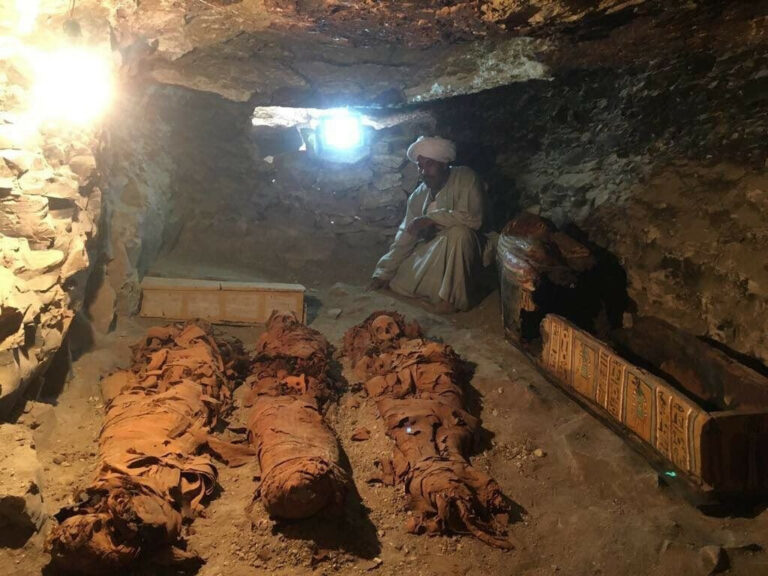Archaeologists working in Upper Egypt have uncovered an extraordinary 3,500-year-old burial site at the ancient quarry of Gebel el-Silsila. Dubbed the “watery tomb,” this site lies approximately 16.5 feet down a shaft where two burial chambers have become naturally filled with saline water from a nearby spring. This unique discovery has provided a wealth of information about the lives and deaths of the individuals buried there, offering new perspectives on ancient Egyptian society and its labor force.

Led by Dr. Maria Nilsson and her dedicated team, the excavation is revealing an incredible window into Egypt’s past. The team has so far unearthed the remains of 50 to 60 individuals, including men, women, and children. The condition of the remains, submerged in water for thousands of years, presents significant challenges but also extraordinary opportunities for understanding the lives of these ancient Egyptians.
Facing Challenges in an Unusual Excavation
Working in the “watery tomb” has been no small feat. The conditions of the site, submerged under saline water, demand innovative approaches to excavation. John Ward, the assistant mission director, vividly described the experience of recovering artifacts and human remains as being akin to working in “a soup of human remains.” Despite these challenges, the team maintains high spirits, often buoyed by the excitement of new discoveries. Ward described each new find as “feeling like Christmas morning,” a testament to the passion and dedication driving this extraordinary project.
The presence of water has added a layer of complexity to the excavation process. The team must carefully document and preserve fragile materials, which are often at risk of further deterioration once removed from their aquatic environment. Nevertheless, these obstacles have not deterred the archaeologists from pursuing their mission to uncover the hidden stories of those entombed at Gebel el-Silsila.
Insights into the Lives of Quarry Workers and Their Families
One of the most striking aspects of this burial site is the presence of remains from not only adult males but also women and children. This finding suggests that Gebel el-Silsila was home to a close-knit community during Egypt’s 18th Dynasty. The presence of entire families at this site challenges the traditional view of quarries as purely utilitarian spaces used only by laborers.
Analysis of the remains has revealed important clues about the lives of these ancient Egyptians. Many of the adult males showed evidence of broken bones and spinal conditions, indicative of the grueling physical labor involved in quarrying stone. The discovery provides a poignant reminder of the human cost behind the grand monuments of ancient Egypt. These workers, likely responsible for extracting stone for temples and statues, endured immense hardships in their daily lives. However, their burials reflect a degree of respect and care that underscores their importance within the community.
Rethinking Assumptions About Ancient Egyptian Laborers
The contents of the watery tomb also challenge long-held assumptions about the lives of ancient Egyptian laborers. Among the artifacts discovered are amulets and shabtis—small figurines traditionally included in burials to serve the deceased in the afterlife. These items suggest that the individuals buried at Gebel el-Silsila were not slaves, as was often assumed of construction workers in ancient Egypt. Instead, they appear to have been part of a recognized and respected working class.
Dr. Nilsson, who has long focused her research on understanding the lives of Egypt’s working population, believes these findings provide a more nuanced picture of social roles in ancient Egypt. The inclusion of these artifacts in the tombs reflects a belief in the afterlife that extended beyond the elite, offering insight into the spiritual and cultural values of the laboring class. This discovery reinforces the idea that these workers were integral to the functioning of ancient Egyptian society and deserved acknowledgment both in life and death.
Ongoing Exploration and Anticipated Discoveries
The excavation of the watery tomb is far from complete. The team continues to investigate the site, including a second chamber that remains partially inaccessible due to water levels, as well as a third sarcophagus that has yet to be opened. Each day brings the potential for new discoveries that could further illuminate the lives of those who lived and worked at Gebel el-Silsila.
One of the most intriguing aspects of this site is the potential for uncovering additional artifacts and remains that may provide even greater insight into the daily lives of ancient Egyptians. The team hopes that further exploration will reveal more about the relationships, beliefs, and traditions of this unique community. Such findings could help paint a richer picture of life during Egypt’s 18th Dynasty, a period marked by significant cultural and architectural achievements.
The Broader Significance of the Watery Tomb
The discovery at Gebel el-Silsila highlights the importance of archaeological work in expanding our understanding of ancient civilizations. While much of the focus on ancient Egypt has traditionally been on its pharaohs and monumental achievements, sites like the watery tomb remind us of the countless individuals who contributed to the grandeur of this civilization. These quarry workers and their families played a vital role in creating the architectural wonders that continue to inspire awe thousands of years later.
Moreover, the challenges faced by the excavation team underscore the need for innovative approaches in archaeology. The submerged conditions of the watery tomb represent a rare but invaluable opportunity to study ancient remains in a waterlogged environment, providing unique preservation conditions that yield extraordinary insights.
As the excavation continues, the work at Gebel el-Silsila promises to deepen our understanding of ancient Egyptian society. Each discovery adds another piece to the puzzle, bringing us closer to understanding the lives, struggles, and beliefs of the people who lived thousands of years ago. The watery tomb is not just a remarkable archaeological find—it is a testament to the enduring human desire to connect with and understand our shared past.





